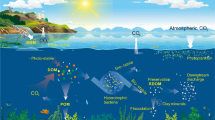Abstract.
The McMurdo Dry Valleys of Antarctica contain many permanently ice-covered lakes that support populations of algae and bacteria in the water column. In these lakes the concentration of dissolved organic carbon (DOC) is typically greatest at depth. In Lake Fryxell, the DOC concentration is 25 mg C/L at 18 m and 5 mg C/L at 5 m, just below the ice-cover. Dissolved humic substances account for about 20–24% of the DOC in the lake water. The DOC sources to the photic zone of this lake are streamflow, extracellular release by phytoplankton and benthic algal mats and upward diffusion across the oxycline at 9.5 m. Experiments with fulvic acids isolated from four depths show that these humic substances have the capacity to act as electron acceptors in the anoxic degradation of acetate by an iron-and humic-reducing microorganism. We used fluorescence spectroscopy to characterize the abundance and redox state of the quinone functional groups in the oxidized and reduced fulvic acids in these experiments and in filtered whole water samples from the lake. The fluorescence intensity of fulvic acid was greater in the oxycline and bottomwaters than in the photic zone. This result suggests that incorporation of quinone functional groups into humic substances may be enhanced in zones of high bacterial activity. Statistical analysis of the excitation emission matrices (EEMs) was used to evaluate trends in the fulvic acid redox state with depth. The results indicate that fulvic acid in the upper photic zone was in an oxidized state and that fulvic acid in the bottomwaters was in a reduced state. The shift in the EEMs indicating a more reduced state occurred in the vicinity of the oxycline (8 to 11 m). The shift in the EEMs began in the zone from 8 and 9 m, where dissolved oxygen concentrations range from to 5 and 10 mg L–1, suggesting that fulvic acid was oxidized upon upward diffusion from the oxycline. This oxidation may be an abiotic process in which reduced humic substances interact with ferric iron generated in this zone.
Similar content being viewed by others
Author information
Authors and Affiliations
Corresponding author
Additional information
Received: 26 May 2003; revised manuscript accepted: 23 September 2003
Rights and permissions
About this article
Cite this article
Fulton, J.R., McKnight, D.M., Foreman, C.M. et al. Changes in fulvic acid redox state through the oxycline of a permanently ice-covered Antarctic lake. Aquat. Sci. 66, 27–46 (2004). https://doi.org/10.1007/s00027-003-0691-4
Issue Date:
DOI: https://doi.org/10.1007/s00027-003-0691-4




